Jadual Kandungan
Harry Charles (H.C.) Syers (1853-1897)
Dirujuk oleh
Sejarah Hidup
1853 (17 Jun): Dilahirkan
1875-1882: Pembentukan Polis Selangor
“Menyusuri sejarah awal pembentukan pasukan polis bermula pada tahun 1874 apabila Davidson dilantik sebagai Residen British. Pembentukan pasukan polis diserahkan kepada seorang pegawai muda bernama Harry Syers. Dalam bulan Julai 1875, beliau dilantik sebagai Penguasa Polis dan Penjara Selangor. Menjelang Oktober 1878 anggota Pasukan Polis Selangor meningkat ke angka 270 dan kesemuanya adalah melayu. Balai-balai polis juga didirikan di Klang, Kuala Lumpur, Damansara, Kubu Lama, Sungai Pelong, Hulu Selangor, Sabak Bernam, Jugra, Kancing, Krian dan Hulu Langat. Pasukan polis tersebut dikenali sebagai Pasukan Polis Tentera Selangor (Selangor Military Police Force). Bermula tahun 1882, IPK Selangor dipindahkan dari Klang ke Kuala Lumpur yang sedang pesat membangun ketika itu. Balai Polis Central terletak di persimpangan Jalan Pudu dan Jalan Cross tetapi pusat pentadbiran polis Selangor yang diketuai oleh H.C Syers, terletak di jalan Bluff dimana terletaknya pejabat Polis Bukit Aman sekarang. Pasukan Polis Selangor dibawah pimpinan Syers terus berkembang pesat terutamanya pada akhir tahun 1880-an dan membentuk sebuah pasukan polis yang cekap di Selangor.” (Khashimah bt. Hj. Ismail, 2015: |"Tekanan kerja di kalangan kakitangan awam di Ibupejabat Polis Kontinjen Selangor, Shah Alam", m.s.5).
“Bila Davidson dilantik sebagai Residen British dalam tahun 1874, salah satu tindakan utamanya ialah menubuhkan Pasukan Polis. Pada masa itu, Klang sememangnya telah mempunyai pasukan polisnya di bawah kawalan Tengku Kudin. Justeru, tidaklah susah kepada Inggeris untuk merekrut anggota yang baharu. Hanya anggota yang berdisiplin sahaja yang dipilih semula. Yang lainnya diberhentikan setelah diberi sedikit pampasan. Selebihnya, diambil anggota baharu dari kalangan orang Melayu dari Melaka. Pembentukan Pasukan Polis diserahkan kepada seorang pegawai muda yang bernama Harry Charles Syers (Kemudian menjadi Pesuruhjaya Polis FMS). Dalam bulan Julai 1875, Harry Charles Syers dilantik sebagai Penguasa Polis dan Penjara Selangor.
'No authentic record can be found of this force, but according to Sir Frank Swettenham (” British Malaya,“ page 221), reliable police forces were only established in each State in 1878, the non-commissioned officers and men being obtained from the British forces that were stationed in the colony at the time. The first Residents were also Chiefs of Police. Syers was chosen early in 1875 for secondment to the newly established colonial regime in the Malay state of Selangor, to raise a police force. On arrival at Klang, he took control of about 100 mercenaries, undisciplined, opium-sodden, and unpaid veterans of the civil war of 1867–73. After discharging those beyond rehabilitation he augmented his force to about 150 by recruiting in the Malay villages around Malacca. Almost all his superiors, including at the outset Frank Swettenham, were convinced that the disorder prevalent in the western Malay states could only be suppressed by a foreign gendarmerie of ‘Sikh’ (Punjabi) troops, to be held at a few central points and sent in as a strike force when required.'
…..
Syers percaya untuk kawalan keselamatan di negeri-negeri Melayu , pasukan polis Melayu perlu dihantar dalam jumlah yang kecil ke kampung-kampung untuk membantu Penghulu dan ketua kampung:
'Syers, however, firmly believed that Malays should man the police force in a Malay state, and that they should be dispersed in small numbers to rural police stations to support the local Malay authorities. Although the dispute continued after Syers's death his policy eventually prevailed in shaping the Malayan police.'
…..
'..In 1881 the force was composed of a superintendent (salary 150 dollars per mensem), a senior inspector (salary 80 dollars per mensem), a junior inspector (salary 70 dollars per mensem), 2 sergeant-majors, 31 non-commissioned officers, and 143 constables. The men received 8 dollars per mensem. The only European officer at this time was Captain Syers, who joined on March 1, 1875,…'
…..
Pada tahun 1885, pasukan polis Selangor terdiri daripada seorang ketua polis berbangsa Eropah,2 orang inspektor berbangsa Eropah, 305 orang polis Melayu termasuk 50 orang Sikh. Pada tahun 1887,jumlah ini meningkat kepada 400 orang.
'..Sir Andrew Clarke encouraged recruitement of Sikhs, and by (the end of) 1880s, Captain H.C Syers had assembled a force of about 530 Military Police, known as the Selangor Sikhs. The State of Selangor has 530 Selangor Sikhs under Captain H.C.Syers.'
'..A succession of British residents of Selangor disparaged each other but agreed that Syers did his job very well. His empathy with his Malay police was a personal tie that became a legend. He was less successful in dealings with the Chinese community since, like many other British officials, he did not know that the Chinese leaders whose co-operation he acknowledged exercised authority in their community through ‘secret societies’, a feature of the social structure of the overseas Chinese. But Syers maintained effective order among the Chinese, bringing to justice in 1895 the criminals who had caused a crime wave (including the theft of three government safes).'”
(Sumber: AKU BUDAK TELOK, Februari 20, 2015: |"SEJARAH AWAL POLIS DI KLANG (1871-1896)").
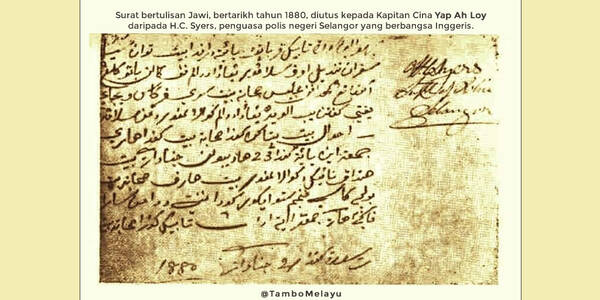
“Berikut adalah sepucuk surat daripada penguasa polis Selangor iaitu H.C Syers yang berbangsa Inggeris kepada Kapitan Cina Yap Ah Loy bertarikh tahun 1880.” (TamboMelayu @ Twitter, 30 Dis 2019: |"Yap Ah Loy juga boleh membaca dan menulis #Jawi").
“Harry Charles Syers (s.a. - 1897) was formerly a private in the 10th Regiment before becoming Superintendent of Police at Klang. He was promoted from the ranks in 1875 when he was engaged by Davidson to work as temporary inspector of police aged about 23, and appointed superintendent in 1875 or 1876. In 1891 he became Captain Superintendent and was appointed Commissioner of Police of the FMS in July 1896. He was fluent in Malay and studied the Chinese and their language. He was the one man Swettenham trusted when he took up his duties in Selangor on 2 October 1882. Syers played a major part in Kuala Lumpur life until his death. A quiet, efficient young man who could handle his incompetent superior Douglas. By the end of 1882 Syers, Swettenham and J.P. Rodgers were the only Europeans left in Selangor.” (Liz Price, 2002: |"Some 19th Century Visitors to Caves in Peninsular Malaysia", m.s.239).
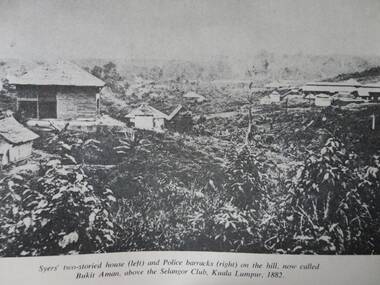

Kiri: “Syers two-storied house (left) and police barracks (right) on the hill, now called Bukit Aman, above the Selangor Club, Kuala Lumpur, 1882.” (Sumber: Sustainable Living Institute (SAVE), December 27, 2013: |"DEATH OF POLICE COMMISSIONER BY SELADANG").
Kanan: “Bluff Road Hill (Bukit Aman), dari kaki bukit. Kelihatan kemungkinan rumah H.C.Syers dan berek polis di puncaknya” (Wikipedia).
1878 (Jun-Julai): Penemuan Batu Caves
“William T. HORNADAY (1 December 1854 - 7 March 1937) was the “discoverer” of Batu Caves. … Hornaday visited Selangor in June - July 1878. He planned a trip into the interior with H.C. SYERS, the Superintendent of the Police. They travelled by ponies from Kwala Lumpor to Batu on the Klang River on 29 June. There they met some Jacoons, the local people, who were familiar with some nearby caves which they used as places of refuge from elephants. On 3 (?) July Hornaday and Syers were on a hunting trip for elephants, and on their way home they were shown a cave, Gua Belah or Double Cave. The next day they explored Gua Lada or Chilli Cave where the Jacoons used to catch bats to eat. In the third cave, Gua Lambong, Hornaday sang to appreciate the resonance in the Cathedral Cave. Syers discharged his rifle which sounded like a deep boom of thunder. They entered the caves using torches of dry bamboo. On the way back to Kwala Lumpor Syers had a bad fall off his pony but was protected by his thick pith helmet.” (Liz Price, 2002: |"Some 19th Century Visitors to Caves in Peninsular Malaysia", m.s.238-239).
1884: Royal Selangor Club
Antara pengasas The Royal Selangor Club: “The club was founded as the Selangor Club in 1884 as a meeting point for educated and high-ranking members of British colonial society. Most of its early members were British, the founding members include H.C. Syers, the Superintendent of Selangor State; A.R. Venning, Treasurer of Selangor and head of the Sanitation Board (who also created the Lake Gardens); A. C. Norman who designed some early buildings of Kuala Lumpur; and H.F. Bellamy who headed the Selangor Public Works Department.” (Royal Selangor Club @ Wikipedia).

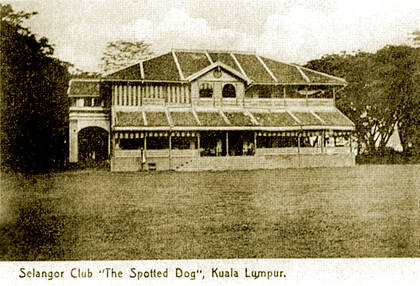
Bangunan asal Selangor Club: “The European social club was founded in 1884. Its building of timber structures was originally located at the east side of the parade ground. In early 1890s, it acquired few premises and built a two-storeyed structure of brick and tiles as the Club's centre-piece, on the west side of the Padang, designed by AC Norman.”
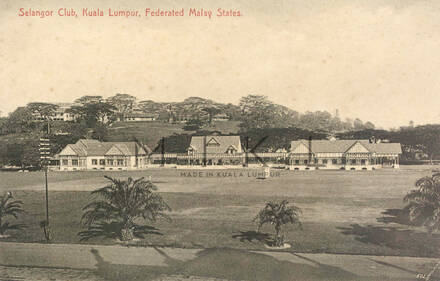

“In 1910, the Clubhouse was extensively extended and renovated to a mock-Tudor style, to the design of AB Hubback, around the original centre-piece that somehow had lost its upper storey. In 1922, further renovation and extension were done which survived until the present day.” (Gambar: MIKL & Heritage Output Lab @ The AB Hubback Project, 2021: |"Selangor Club 1910, Kuala Lumpur").
(Sumber petikan dan gambar: PAM Heritage Conservation Committee (pamhericon): |"Old Selangor unmasked; KL, Klang").
1886 (16 September): Perasmian Keretapi KL-Klang

“The grand opening of the KL-Klang railway, at the first KL Railway Station (thatched roof), located on present-day Textile Museum. The stripes were actually red & yellow, according to contemporary news report. Bluff Hill in the background, 16 Sept 1886: From Sultan Abdul Samad, to his left: Frederick Weld the Governor of S.S, Lady Weld, J.P. Rodger the Selangor Resident, Yap Ah Shak the Kapitan China, and H.C. Syers the Superintendent of Police in front of the guards.” (pseudanon @ Skyscraper City, Oct 3, 2017: |"The grand opening of the KL-Klang railway"). (Gambar: G.R Lambert & Co, Singapore, A black & white print, from a disbound book The Queen's Empire 2. 1899 @ Cetak Nadir: |"Railway Enterprise In The Malay Peninsula by G.R Lambert & Co. (1899)").
“After a short and pleasant run the train arrived at the terminal station at Kwala Lumpur, where some of the principal residents, including a number of ladies, were waiting to receive the governor, Lady Weld and the Misses Weld, and the Sultan. Among the ladies were Mrs. Venning, Mrs. Spence Moss, Mrs. Belfield and Mrs. Bellamy. the station was beautifully decorated, and a guard of honour commanded by Mr. H. C. Syers the Superintendent of the Selangor Police Force was in attendance. On the platform of the station Mr. Rodger, the Acting Resident of the State of Selangor, addressed His Excellency the Governor in a speech full of interest…” (Straits Times Weekly Issue, 15th Sept. 1886, Pages 7, 8 & 9 @ Malcom Wilton-Jones: "The Opening of the Selangor Railway").
1887: Pengasas Muzium Selangor
“'Pengasas penubuhan Muzium Selangor ialah H.C.Syers, dimana pembinaan ini telah dimulakan pada tahun 1888 dan siap sepenuhnya pada tahun 1904. Usaha-usaha mengumpulkan artifek-artifek zaman pra-sejarah untuk dipamerkan di muzium tersebut telah bermula sejak tahun 1894 lagi di mana J.P.Rodger telah menghadiahkan beberapa kapak dan beliung yang dikenali sebagai `Batu Lintar` pada masa itu kepada muzium tersebut.' (Ahmad Kamal Muhamad & Mohd. Zainudin Haji Abdullah, Sejarah Dan Perkembangan Muzium Selangor Sehingga Terbinanya Muzium Sultan Alam Shah, Shah Alam (1887-2002), Seri Alam, Jurnal Lembaga Muzium Selangor Darul Ehsan, Bil. 7, 2002/2003, hlm. 130).” (Dr Shafie Abu Bakar, July 30, 2013: |"Dilema Sejarah Permuziuman Negeri Selangor: Sambutan Satu Suku Abad Lebih Tepat").
“Unlike the Raffles Museum, founded under government auspices in 1849, and the Perak Museum, which owed its inception to Hugh Low, the Selangor Museum was started in 1887 through the initiative of leading local residents. Chief among the founders was Captain H.C. Syers, First Commissioner of Police and a keen hunter.” (Jeyamalar Kathirithamby-Wells, 2005: |"Nature and Nation: Forests and Development in Peninsular Malaysia" (PDF), m.s.168).
LATAR PERISTIWA: Muzium Kuala Lumpur / Muzium Negara.
1896 (1 Julai): Dilantik Federated States Police Commissioner
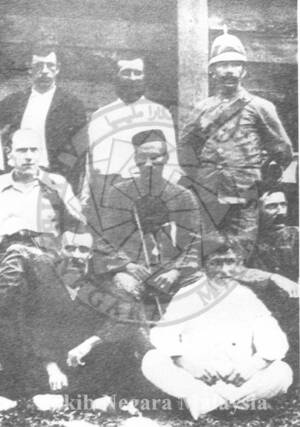
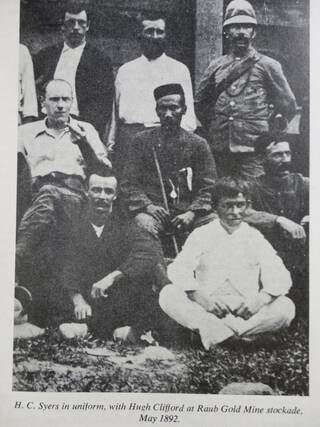
“H.C. SYERS BERUNIFORM PENUH (BERDIRI DI SEBELAH KANAN SEKALI) BERSAMA HUGH CLIFFORD DAN RAJA IMPEH (DUDUK DI ATAS KERUSI) DI LOMBONG EMAS STOCKADE, BULAN MEI 1892.” (POLIS DIRAJA MALAYSIA - MUZIUM POLIS, 01/05/1892: |"H.C. SYERS BERUNIFORM PENUH (BERDIRI DI SEBELAH KANAN SEKALI) BERSAMA HUGH CLIFFORD DAN RAJA IMPEH (DUDUK DI ATAS KERUSI) DI LOMBONG EMAS STOCKADE, BULAN MEI 1892").
“The British resident system was established in the Malaya states in 1874, pioneered by Perak. In 1895, four Federated Malay States were merged into a federation. The federation united all its police forces on 1 July 1896. According to the federation's constitution, the police force, customs, Department of Survey, labour and defence departments were placed under government jurisdiction (headquartered in Kuala Lumpur). Its police force was headed by a commissioner and a chief of police. … The first Federated States Police Commissioner was Captain H. C. Syers (superintendent of Selangor), moved the state police headquarters from Klang to Kuala Lumpur. … Under Syers, the police changed; a blue uniform was introduced. State uniforms were differentiated by the shape of the button and badge. Syers reformed police administration in Perak. At that time the Perak contingent had 842 members, 15 European officers, 472 officers, Sikh and Pathan officers, 14 orderlies and 302 lower-ranking officers and Malay constables. In Selangor there were six European police officers, 32 Pathans and 500 lower-ranking officers and Malay constables. With the establishment of the Malay States Guides under Robert Sandilands Frowd Walker in 1896, the police force was increased to six infantry companies and two artillery companies (900 members).” ("History of the Royal Malaysia Police: Federated Malay States").
1897 (14 Julai): Terbunuh oleh Seladang Buruan
“Shortly before his death, Syers reported the excitement among the aborigines at Batu, Selangor, at the prospect of a hunt for seladang.” (Jeyamalar Kathirithamby-Wells, 2005: |"Nature and Nation: Forests and Development in Peninsular Malaysia" (PDF), m.s.194).
“Syers died on 14 July 1897 in central Pahang from wounds inflicted by an enraged, wounded seladang. He was buried in Pekan, but in 1899 his body was exhumed at Swettenham's request with the assistance of Dr. E.A.O. Travers, and brought to Kuala Lumpur for reinternment. Some 60,000 mourners attended the funeral parade. He had been held in esteem by all races and classes in Kuala Lumpur society.” (Liz Price, 2002: |"Some 19th Century Visitors to Caves in Peninsular Malaysia", m.s.239).
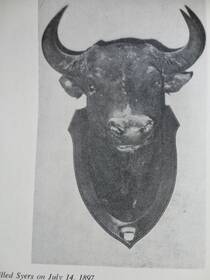
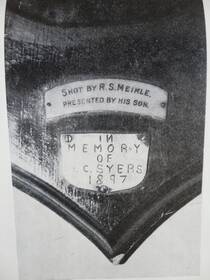
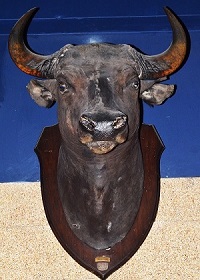
Kiri: “The killer seladang was later hunted and killed by R.S. Meikle. The head of the seladang was made into a trophy in memory of Syers.”
Tengah: “Inscription at the bottom of the trophy.”
(Sumber: Sustainable Living Institute (SAVE), December 27, 2013: |"DEATH OF POLICE COMMISSIONER BY SELADANG").
Kanan: Gambar warna: “This seladang on display at the Royal Malaysia Police Museum is said to be the one that gored H.C. Syers to death in 1897” (pseudanon @ Skyscraper City, Oct 3, 2017: |"The grand opening of the KL-Klang railway").
Sumber Lain
Berikut adalah kisah bekas pegawai perhutanan, Granville O'Hara, sebagaimana dilaporkan di dalam akhbar tahun 1931. Kisah berikut ini diceritakan kepadanya oleh malim Syers dan kawannya ketika itu, bernama Ma'ali (mungkin Mat Ali) yang tinggal di Kuala Krai (mungkin Kuala Krau), Temerloh. Menurutnya, Syers sendiri yang membunuh seladang itu, sejurus sebelum dibunuh olehnya. Mayat beliau terus dibawa pulang ke Kuala Lumpur untuk dikebumikan. Menurut O'Hara, kepala seladang itu turut dibawa pulang, dan diletakkan di muzium, sebelum dipindahkan ke Selangor Club, sebelum akhirnya dibawa pulang ke England oleh balunya:-
“Mr. Granville O'Hara's Lecture at Hu Yew Seah:-
Death of Well-Known Shikari Recalled.
Despite counter-attractions, a fairly large gathering was present at the Hu Yew Seah yesterday evening to hear a lecture on 'Some Peculiarities of Malayan Wild Animal Life' by Mr. G.M.O Hara, late of the Malayan Forest Service.
For over an hour and a half Mr. O'Hara kept his audience interested with innumerable little anecdotes and amusing incidents connected with jungle life. The following are some excerpts from the lecture:-
…..
Some thirty years back Captain Sayers, the late Commissioner of Police, Selangor, and the greatest Shikari Malaya has ever seen, was killed by a Seladang in the wilds of Pahang. There are various versions as to how Sayers came to meet his death at the hands of a Seladang, but I shall tell you what I heard from an old Malay Shikari at Kuala Krai Pahang, who accompanied Captain Sayers on his last and fateful shoot. I was always keen on visiting the spot where he was killed, so when stationed in the Temerloh District in Central Pahang, I looked up this old Malay at Kuala Krai and accompanied by him and a couple of my Forest Guards visited the area where poor old Sayers was killed.
According to this old Malay, Sayers arrived at Kuala Krai with another friend - a Scotsman named MacKenzie. The next morning, accompanied by this old Malay Ma'ali and two other Malay trackers, they poled up the Sungei Krai from off the Pahang river and that afternoon camped on the bank. Early the next morning, having located a herd the previous afternoon it is allegged that Sayers, MacKenzie, Ma'ali and the two Malay gun-bearers went in quest of this herd, old Ma'ali leading the way.
Well in the forenoon they came up with the herd and as this was MacKenzie's first expedition and being keen to bag his first Seladang, the order of approaching this herd was reversed by MacKenzie taking Sayer's place behind Ma'ali. About half an hour afterwards Ma'ali spied a bull partly hidden behind a bertam clump a little distance off and drew Sayer's attention to it, who in turn tried to draw MacKenzie's attention to the animal.
The latter not being an experienced hunter was not able to locate it, and it is alleged that in his excitement he made more noise than was necessary, with the result that the seladang was on the charge before they knew what was happening. MacKenzie fired and missed and tried to get out of the way, but being lame in one leg he tripped over a creeper and went sprawling out of the way of the charging seladang, and this unfortunate mishap sounded the death-knell of poor old Sayers.
Sayers who was deliberately behind MacKenzie before the mishap, now found himself standing directly in the way of the charging brute, who was almost on him, so he fired point blank and mortally wounded the brute. This checked the charge but not before the seladang got Sayers in the ribs and bored a hole clean through him. It is alleged that the brute then shook Sayers off his horns and threw him twenty feet up in the air and on the descent did the same thing once again and then toppling over on its side, went to sleep for good.
Sayers' body, which was literally parted in two, was taken down the Pahang river and into Kuala Lumpur and buried in the cemetery there. The trophy was brought down and after the head had been stuffed was placed in the Museum for some years from where it was later removed and placed in the bar-room of the old 'Spotted-Dog' (the Selangor Club), and a few years back it was removed by Capt. Sayers' widow to England.”
(Sumber: Pinang Gazette and Straits Chronicle, 7 November 1931, Page 4: |"The Origin of the Malay “Ronggeng”").
Peninggalan
“The Editor, as a personal friend of the late Capt. H.C. Syers, Commissioner of Police, F.M.S. has received from Dr. Travers, Kuala Lumpor, a valuable and appropriate memorial of that much regretted officer, who was killed in Pahang by a sladang last July while shooting in the ulu Telamong.” (The Singapore Free Press and Mercantile Advertiser, 18 December 1897, Page 2: |"THE LATE CAPT.H.C. SYERS").
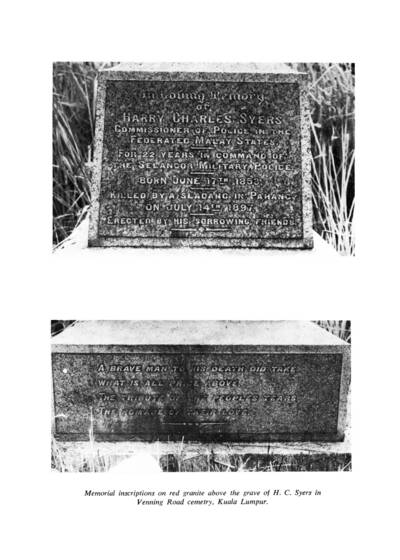

“Memorial inscriptions on red granite above the grave of H.C. Syers in Venning Road cemetry, Kuala Lumpur.” (J. M. GULLICK @ Journal of the Malaysian Branch of the Royal Asiatic Society Vol. 51, No. 2 (234), 1978: |"SYERS AND THE SELANGOR POLICE 1875 - 1897", pp. 1-57).
Pengakuan penting: Kami bukan ahli sejarah! Sila klik di sini untuk penjelasan lanjut.